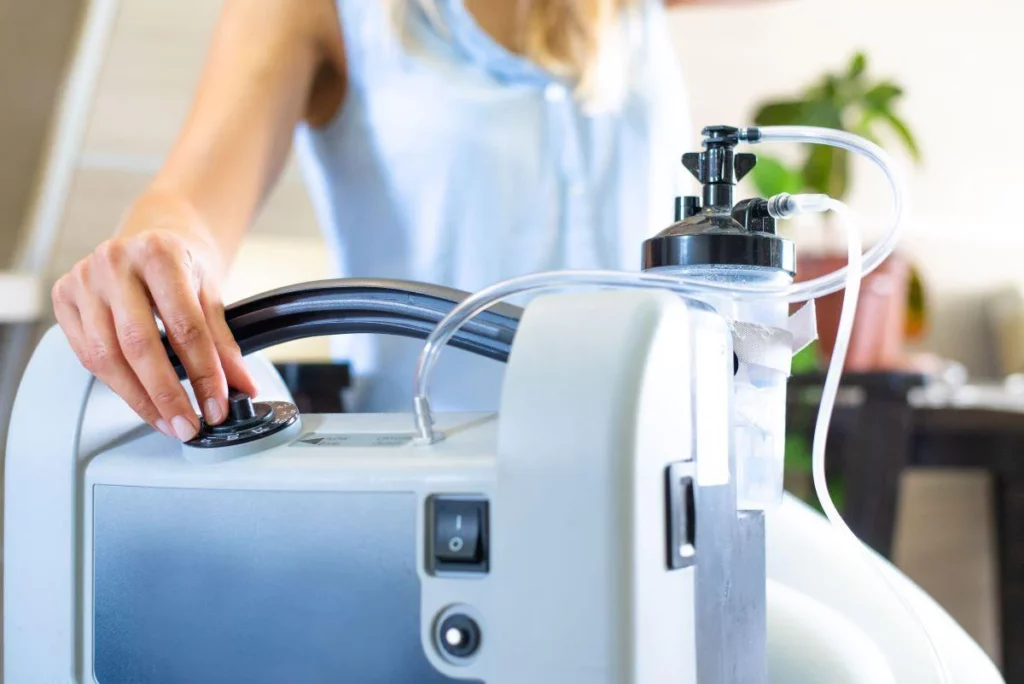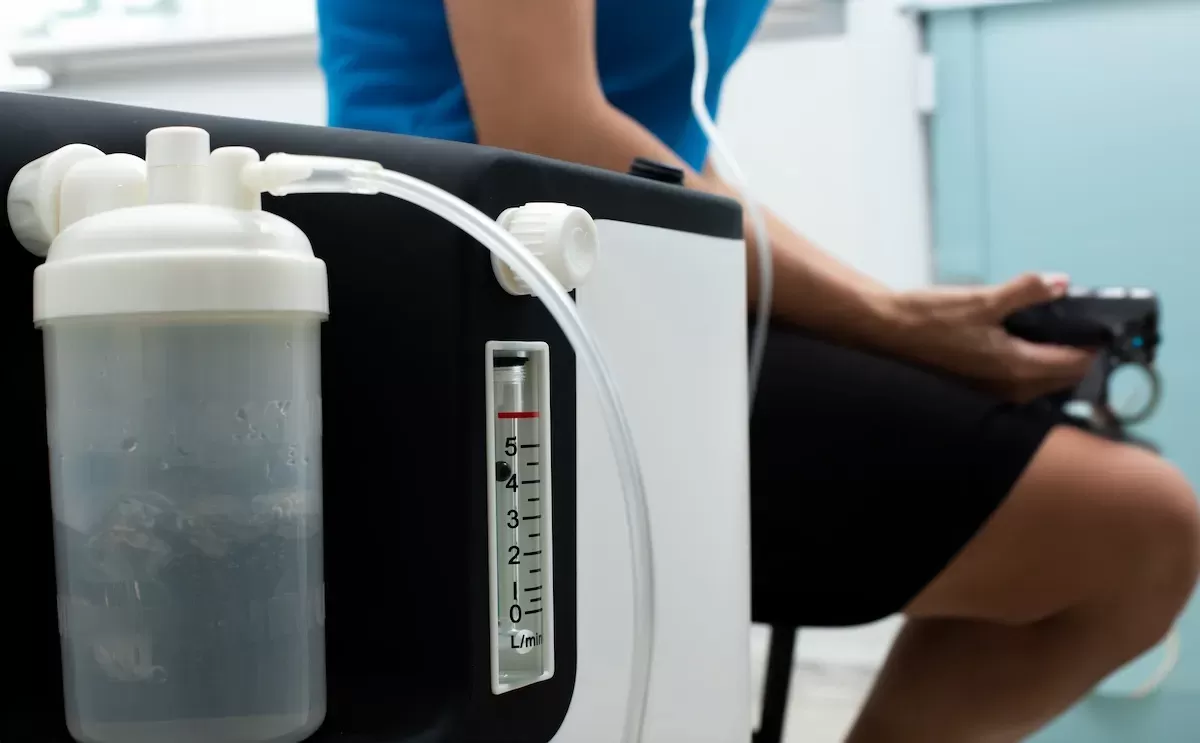Portable oxygen concentrators (POCs) are a game-changing innovation in respiratory care technology. These small medical devices take in oxygen from the surrounding air, filtering out nitrogen and other gases to provide concentrated oxygen to individuals who need extra breathing support.
For those living with respiratory conditions, POCs offer an unparalleled level of freedom and mobility. Unlike traditional oxygen tanks, these lightweight devices allow users to:
- Stay active and pursue physical activities
- Travel without restrictions
- Engage in social gatherings and events
- Carry out daily tasks independently
POCs work by pulling in air from the atmosphere and passing it through specialized filters called sieve beds, which separate oxygen from other gases. The result is high-quality oxygen that meets specific prescription requirements. This purified oxygen is then delivered to the user via a nasal cannula or mask, ensuring essential breathing support wherever it’s needed.
This guide explores everything you need to know about portable oxygen concentrators. We’ll cover topics such as the different types of devices available, how to choose features that suit your needs, and what accessories are important for optimal usage. Additionally, we’ll provide insights into reputable brands in the industry and factors to consider when making a purchase decision.
If you’re thinking about buying one of these life-changing devices, you can shop for Portable Oxygen Concentrators online with Air Liquide. They offer a wide range of products from top brands including Zen-O, Inogen, Philips, and more.
Understanding Oxygen Therapy and Its Benefits
Oxygen therapy is a crucial medical treatment for people with breathing problems. It involves providing extra oxygen to ensure that the levels in the blood are sufficient, which is important for the proper functioning of organs and cells.
Portable oxygen concentrators come in two distinct delivery types: pulse dose and continuous flow units. Each type serves specific medical requirements and lifestyle needs.
Common Respiratory Conditions Requiring Oxygen Therapy:
- Chronic Obstructive Pulmonary Disease (COPD)
- Severe Asthma
- Sleep Apnoea
- Cystic Fibrosis
- Pneumonia
- Lung Cancer

How Portable Oxygen Concentrators Work
Portable Oxygen Concentrators (POCs) use advanced filtration technology to convert regular air into medical-grade oxygen. Here’s how the process works:
- The device takes in air from the room.
- It removes nitrogen using a method called pressure swing adsorption (PSA).
- The remaining oxygen is compressed and concentrated to therapeutic levels (90-95%).
- Purified oxygen is then delivered through a nasal cannula or mask.
Read more at: Mini Portable Oxygen Concentrators Compact Solutions for Everyday Use
Benefits of Oxygen Therapy with POCs
Oxygen therapy using POCs can greatly improve the quality of life for individuals with chronic respiratory conditions. Here are some key benefits:
- Increased physical endurance
- Enhanced mental alertness
- Better sleep quality
- Greater independence in daily activities
With POC technology, patients can now receive medical-grade oxygen therapy in a portable device that fits their active lifestyles. This advancement in respiratory care allows them to maintain optimal oxygen levels while going about their daily routines, exercising, or even sleeping.
In summary, oxygen therapy plays a vital role in managing respiratory conditions by ensuring adequate oxygen supply to the body. Portable Oxygen Concentrators offer a convenient solution for individuals seeking mobility without compromising their treatment needs.
Types of Portable Oxygen Concentrators
1. Pulse Dose Units
- Delivers oxygen in measured bursts when the user inhales
- Utilises breath detection sensors to synchronise with breathing patterns
- Conserves oxygen by delivering only during inhalation
- Ideal for active users with mild to moderate oxygen needs
- Typically lighter and more compact than continuous flow units
2. Continuous Flow Units
- Provides uninterrupted oxygen delivery at a steady rate
- Delivers a consistent stream regardless of breathing pattern
- Essential for patients requiring oxygen during sleep
- Suitable for high-flow oxygen requirements
- Often larger and heavier due to increased capacity
Flow Rates and Prescription Considerations
- Pulse dose units: 1-6 settings correlating to millilitres per breath
- Continuous flow units: 0.5-3 litres per minute
- Medical prescriptions specify required flow rates and delivery type
- Higher flow rates generally indicate need for continuous flow
- Prescription requirements determine suitable device options
The selection between pulse dose and continuous flow concentrators depends on individual oxygen requirements, activity levels, and specific medical conditions. Patients with varying oxygen needs throughout the day might benefit from dual-delivery devices that offer both pulse and continuous flow options. Read more about devices at https://bioinnovation.engineering.uconn.edu/technologies/bio-devices-technology/

Key Features to Consider When Buying a Portable Oxygen Concentrator
Selecting the right portable oxygen concentrator, such as the Philips Everflo, requires careful evaluation of several critical features that impact daily use and effectiveness:
1. Oxygen Delivery Settings
- Precise flow settings matching prescribed oxygen requirements
- Multiple flow settings for flexibility during different activities
- Digital display showing current flow rates and settings
2. Battery Performance
- Standard operation time: 2-8 hours per battery
- Availability of spare batteries
- Charging options (AC/DC adaptors, external battery packs)
3. Physical Specifications
- Weight range: 2-9 kg
- Dimensions suitable for intended use
- Carrying options (shoulder straps, wheeled cart compatibility)
4. Operation Comfort
- Noise levels between 40-50 decibels
- Heat output management
- Display visibility in various lighting conditions
5. Travel Compliance
- FAA approval documentation
- Maximum altitude specifications
- International voltage compatibility (100-240V)
6. Warranty Protection
- Standard coverage period (typically 3-5 years)
- Parts and labour inclusion
- Battery replacement terms
- Service centre availability
7. Additional Safety Features
- Oxygen purity indicators
- Low battery alerts
- Altitude compensation
- Auto-shutoff protection
When considering these factors, it is also important to explore additional options like CPAP masks for enhanced comfort during sleep. You can find a variety of CPAP masks online, offering fast delivery Australia-wide.
Popular Brands and Models of Portable Oxygen Concentrators
The portable oxygen concentrator market features several established manufacturers known for their reliable and innovative products. Here’s a detailed look at the leading brands and their standout models:
Philips Respironics
- EverGo: Delivers up to 6 settings of pulse dose oxygen, weighs 4.5 kg, features user-replaceable batteries
Inogen
- One G3: Ultra-quiet operation, 2.2 kg weight, up to 4.5 hours battery life
- One G4: Most compact model at 1.3 kg, ideal for travel
- One G5: Latest model offering 6 flow settings, extended battery life up to 13 hours
SeQual Technologies
- Eclipse Series: Provides both continuous flow and pulse dose options, suitable for 24/7 use
- Eclipse 5: Features autoSAT® technology, adjusting to breathing patterns
Invacare
- Solo2: Offers 5 pulse dose settings, weighs 3.2 kg
- Platinum Mobile: Includes advanced oxygen sensing technology, quiet operation at 40 dB
AirSep
- FreeStyle: Ultra-portable at 2 kg, 3 pulse settings
- FreeStyle 5: Enhanced capacity with 5 pulse settings, includes ergonomic carrying case
Each manufacturer incorporates unique technologies and features in their devices, catering to different user requirements and lifestyle needs. These models represent various combinations of portability, battery life, and oxygen delivery capabilities.
For those who require a more stationary solution or additional support during sleep, it’s worth considering CPAP machines which can be found at Air Liquide Healthcare. They offer a wide selection from top brands including ResMed, BMC, and Fisher & Paykel.
Alternatively, if you’re in need of a home oxygen machine, Air Liquide also provides an extensive range featuring products from leading brands such as Inogen and Philips.
Advantages and Limitations of Using a Portable Oxygen Concentrator
Portable oxygen concentrators offer distinct advantages while presenting specific limitations users should consider.
Key Benefits:
- Compact, lightweight designs allow users to maintain active lifestyles
- Battery-powered operation supports independence from wall outlets
- Multiple charging options including AC/DC and car adaptors
- Simple controls enhance ease of use
- Silent operation modes for discreet oxygen therapy
Notable Limitations:
- Higher initial cost compared to traditional oxygen tanks
- Regular maintenance requirements
- Battery life varies based on flow settings
- Some models struggle with high-altitude performance
- Limited oxygen output compared to stationary units
The latest POC models feature advanced battery technology, delivering up to 8-12 hours of continuous use on a single charge. This extended battery life enables users to participate in daily activities without constant recharging concerns. The lightweight nature of modern POCs, typically ranging from 2-4 kg, allows users to carry their units comfortably using shoulder straps or wheeled carts. Click here to find more about comfortably.
POC technology continues advancing, with manufacturers developing units that balance portability with enhanced oxygen delivery capabilities.
How to Select the Right Portable Oxygen Concentrator for Your Needs
Choosing the right portable oxygen concentrator (POC) involves understanding your medical needs and how you live your life. It’s important to talk to a healthcare provider who can help you make this decision.
Medical Requirements:
When considering your medical needs, take into account the following factors:
- Prescribed oxygen flow rate
- Delivery method (pulse dose vs continuous flow)
- Duration of daily oxygen therapy
- Required oxygen concentration levels
In addition to these factors, it’s worth exploring supplementary devices like the Aerobika with Manometer, which can enhance your overall respiratory therapy by meeting your OPEP needs.
Lifestyle Considerations:
Your lifestyle also plays a crucial role in selecting the right POC. Consider the following aspects of your daily life:
- Daily activity patterns
- Travel frequency and destinations
- Work environment demands
- Living arrangements and storage space
The selection process should begin with a thorough medical assessment by a qualified healthcare professional. This assessment determines the specific oxygen requirements, which then guides the technical specifications needed in a POC.
A practical approach involves keeping a daily activity log for 1-2 weeks before the consultation. This log helps identify patterns in oxygen usage, activity levels, and mobility requirements. The healthcare provider can then match these patterns with appropriate POC specifications.
For frequent travellers, FAA-approved models become essential. Active individuals might prioritise lightweight units with robust battery life, while those with varied oxygen needs might require dual-flow devices.
Accessories That Enhance Usability and Comfort with Portable Oxygen Concentrators
Essential accessories enhance the functionality and comfort of portable oxygen concentrators while proper maintenance practices extend device longevity.
Essential Accessories Include:
- Nasal Cannulas: Soft, flexible tubes that deliver oxygen directly to the nose. Multiple sizes ensure proper fit and comfort
- Oxygen Masks: Alternative delivery method for users requiring higher flow rates or face-breathing preference
- Replacement Batteries: Extra power sources enable extended mobility and uninterrupted oxygen delivery
- Carrying Cases: Protective cases with padding and ventilation features safeguard the device during transport
Maintenance Requirements:
- Clean or replace nasal cannulas every 2-4 weeks
- Wipe external surfaces with a damp cloth daily
- Replace particle filters monthly
- Schedule professional servicing every 12 months
- Store in a dry, dust-free environment
A well-maintained portable oxygen concentrator with appropriate accessories delivers optimal performance and extends the device’s operational life. Regular cleaning, filter replacement, and professional servicing prevent mechanical issues and ensure consistent oxygen delivery.
Conclusion
Choosing the right portable oxygen concentrator is an important step towards greater independence and a better quality of life. By carefully assessing individual needs and seeking professional medical advice, you can make an informed decision.
The ideal POC strikes a balance between medical requirements and lifestyle preferences, allowing users to lead active and fulfilling lives while receiving necessary oxygen therapy.
The process of finding the perfect portable oxygen concentrator begins with understanding your personal needs and ends with the ability to breathe comfortably. By consulting healthcare providers, researching trusted brands, and considering long-term usability factors, you can set yourself up for a successful POC experience that promotes both health and independence.

